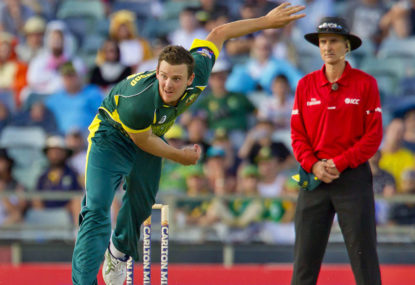Bona fide 'passengers', no-brainers and 'Agar from Wish': A candid look at India's perplexing T20 WC squad
India have announced their 2024 ICC Men’s T20 World Cup squad which is set to be played in the USA and Caribbean. The 15-man…

Since the recently concluded World Cup Down Under, I have started to feel a little bored by 50-over cricket.
I know that many love explosive batting, high scores and loads of runs. But I would prefer to see 500 runs over both innings and an exciting battle between the bat and ball, followed by a tight last-over finish, rather than have 700 runs where bowlers are just shattered.
We know that 250 is the new 300, but isn’t having 300 as the new 400 boring?
The trends below compare data before and during the 2015 World Cup (the source of the data is cricinfo.com).
Before the World Cup the average first innings score was around 228 and during the World Cup it was 282. If we consider the average for teams who have batted until the end of first innings, the average comparison would be 250 and 300. The fielding restrictions and the rule of two new balls have been a greater help to batsmen than the bowlers
Before the World Cup, the average over at which the score doubled was exactly at the 30 over mark. Post World Cup it has moved to 33.4 overs. This means what you score in two-thirds of your innings gets replicated in the final one-third.
The average runs scored and wickets lost in the first 10 overs remains almost static at 43 and 47.
Innings where 300 or more runs were scored has increased from a mere 12 per cent to almost 40 per cent. Wow, that’s a steep increase!
Runs scored in boundaries were approximately 38 per cent before the World Cup and 48 per cent in the World Cup
There were an average of 6.1per cent maiden overs came before the World Cup, but this came down to a mere 4 per cent during the World Cup
The scoring rate, which has been well below 5.0 in all the ODIs and World Cup matches up to 2007, jumped by about 10 per cent to 5.03 in the 2011 World Cup. That was understandable. But there is another jump by over 10 per cent in this World Cup. It is clear that this is a combination of the new rules, fearless batting methods, and the changes in pitches in Australian and New Zealand.
The above points tell us two things: the dominance of batsmen in the game has increased, and the change in rules somehow end up favouring the batsmen.
ODI cricket needs a radical overhaul in rules and playing conditions. Here are my suggestions:
1. Allow the bowlers to change bowling side
As batsmen are allowed switch hits, movement around the crease, the bowlers too must be allowed to switch sides once or twice in an over without informing the umpire or the batsman. That would be some fun!
2. Have some restriction over switch hits and movement around the crease
These innovative steps by the batsmen should be limited. Limit the switch hit to one or two and the movement around the crease can be limited by some relaxation on such deliveries being called wides.
3. Height of the stumps
Most cricketing gear has evolved. Bat size and shapes have changed, the ball’s material and colour has been experimented with. But nothing has happened to the stumps. With most rules being batsmen friendly, increasing the height of the stumps helps the bowlers.
4. Field restrictions
This has been the most debated rule. There should be no field restrictions after the first 10 overs. The batting powerplay should be taken between 11th and 40th over. The field restrictions should apply to the powerplays only. The powerplays have been good for both batting and bowling – they leak more runs but teams also lose many wickets.
5. Two new balls should not be used in an innings
The ball can be replaced with a similar aged ball if it loses colour.
6. Player substitution should be allowed
With limitations on the type of player (basis skill), count of substitutions and the timing of substitutes.
This would help utilisation of the entire squad, better bench strength and would make the game more exciting. I know that the sub rule was there for a while but that was very boring. For substitution we look to football’s methods.
7. Limitation on the number of overs that a bowler can bowl
If the top batsmen can bat throughout the innings, why is the top bowler capped on 20 per cent of the innings? At least one bowler should be given the freedom to bowl more overs.
E.g. If one bowler is allowed to bowl one-third of an innings (say 16 overs), it would still be less than half of the deliveries that the top-order batsmen might face and would be a fair contest. It would also give a breather to captains whose fifth and sixth bowlers are taking a pounding. It gives the fielding side some chance of maintaining control through the late overs when boundaries are raining down on the spectators.
It is difficult to get a perfect solution but the ICC should think about restoring the balance of the game, or else the batting display will become too monotonous.